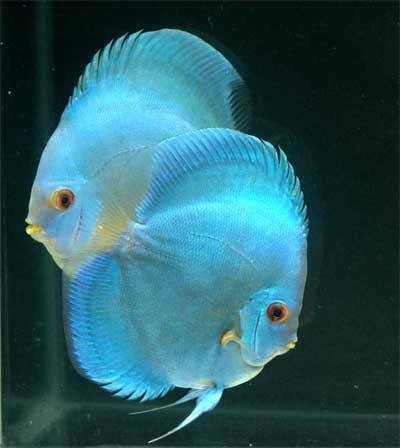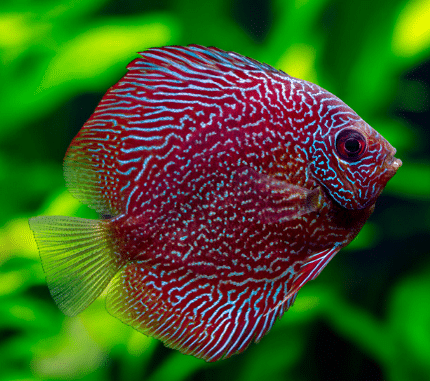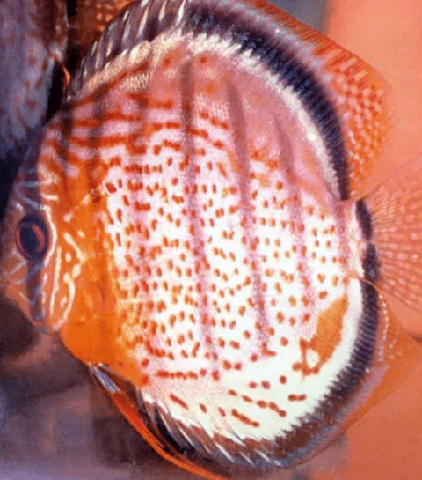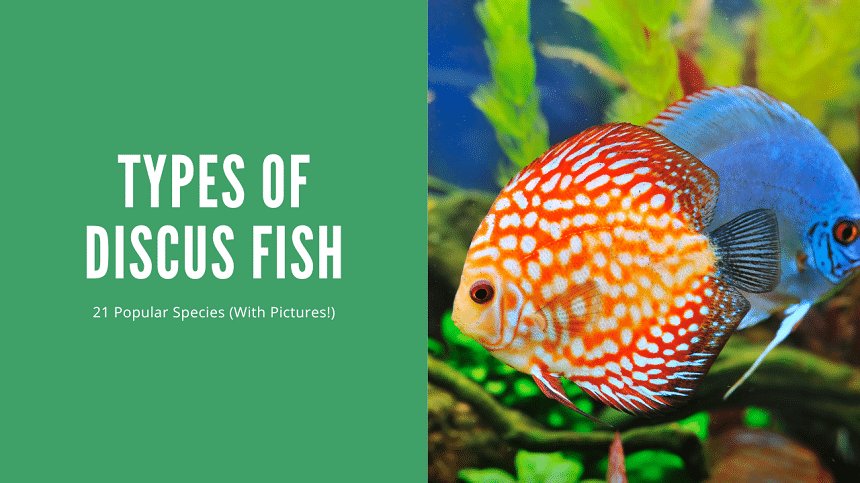Thank you for visiting! By the way… any links on this page that lead to products on Amazon and other stores/partners are affiliate links Aquarium Store Depot earns a commission if you make a purchase.
The discus fish is one of the world’s most sought-after freshwater aquarium species and they are often referred to as the king of aquarium fish. These cichlids have been bred into a multitude of amazing colors and patterns. Some you can find at your local fish store, but others are rare and valuable.
This article is for all the discus lovers out there, so read along to learn about 21 amazing discus fish types. We’ll also cover some basic topics about their care, so stick around if you’re considering keeping ‘the king’ in your own aquarium.
Let’s dive in!
Key Takeaways
- Discus fish are one of the world’s most sought-after aquarium fish
- These unique South American cichlids are available in countless beautiful and colorful strains or breeds
- Discus require excellent water quality and high temperatures. They are not recommended for beginners
A Brief Species Overview
Discus fish are tropical freshwater fish from the cichlid family. There are three species of discus in the Symphysodon genus, namely the Heckel discus (Symphysodon discus), the green discus (S. tarzoo), and the blue discus (S. aequifasciatus).
These disc-shaped fish come in many different color forms, both natural and developed by selective breeding in captivity. Adult discus are large fish that can reach a length of about 8 inches in captivity, although adults typically reach 6 inches. Despite their flattened shape, these fish get surprisingly heavy, and adults weigh about half a pound.
Why Are They So Popular?
Discus fish are some of the world’s most beautiful fish species. They are fairly challenging to care for and come in a variety of rare and sought-after breeds, making them ideal for more experienced fish keepers and breeders.
Nothing quite beats a well-lit display tank with a group of several types of discus. With the right care, these gorgeous fish can live for an impressive ten to 15 years, so they can brighten your home for a long time too!
Where It All Started
Discus fish were first discovered by European explorers in the 1800s but it wasn’t until the 1930s that the first fish successfully survived the trip to the Old World1.
These naturally colored fish became popular with breeders in Europe and Asia, and many new strains began to appear in the 1980s and 1990s, including color breeds completely different from their wild ancestors.
After nearly a century in captivity, the king of aquariums remains as popular as ever and is now kept in fish tanks all over the world!
Natural Habitat
Discus fish (also known as pompadour fish) are native to the tropical freshwaters of the Amazon River Basin in South America. They live in still and very slow-flowing warm water habitats near the bank of clear lakes and river courses.
These fish prefer areas with a sandy bottom among driftwood and the roots of trees. The water in their natural habitat is generally warm, soft, and slightly acidic.
The Top 21 Discus Fish Types
Discus breeding is a fascinating topic, and the amount of different types of discus fish in the hobby today is quite remarkable. We got a video from our YouTube Channel you can check out while you read along on our blog. If you like this content, but sure to subscribe as we post new videos every week!
Let’s take a look at 21 of the most discus fishes that you can keep!
1. Heckel

- Adult Size: up to 8 inches
- Color Pattern: Red, brown, blue, turquoise
- Unique Traits: Very rounded body shape and dark vertical bars
The Heckel discus (Symphysodon discus) is a wild discus species, first described by an Austrian ichthyologist in the mid-1800s. They are also known as the red discus.
These beautiful but challenging fish are native to the Rio Negro and other major tributaries of the Amazon River. This species can be identified by nine vertical stripes along its body, and the fifth stripe is particularly bold.
2. Wild
- Adult Size: up to 8 inches
- Color Pattern: Various
- Unique Traits: Round body shape and natural coloration
Wild discus fish are simply fish that have not been selectively bred into new colors and patterns. Wild discus can be from any of the three recognized discus species.
While they may not have the impressive solid colors of some of the newer breeds, wild discus are still incredibly beautiful fish.
3. Blue Diamond

- Adult Size: 6 inches
- Color Pattern: Solid Blue
- Unique Traits: Deep oval shape and unpatterned body
The blue diamond discus is an attractive metallic blue breed first developed in Asia in the early 1990s. These oval-shaped fish have been bred to be a solid base color without vertical bars, although their eyes are typically deep red. As captive-bred fish, they are often hardier than wild-caught discus.
4. Red Turquoise

- Adult Size: 6 inches
- Color Pattern: Red and turquoise
- Unique Traits: Light blue color with beautiful red patterns
As their name suggests, the red turquoise discus is a breed that combines two striking colors. They are an early breed, first developed in Asia in the 1980s.
Their background body color is a metallic turquoise shade, covered in deep red markings that extend onto their fins. They may be predominantly blue (blue base) or mostly red (red base).
5. Brilliant Turquoise
- Adult Size: 6 inches
- Color Pattern: Turquoise & green
- Unique Traits: Greenish tint
The brilliant turquoise discus combines bright turquoise and beautiful green shades with dark red eyes. These fish also feature fine reddish markings and may have some darker vertical stripes.
The brilliant turquoise discus is one of the most colorful breeds and is perfect for a dramatic display tank with other discus strains.
6. Tangerine
- Adult Size: 6 inches
- Color Pattern: Orange
- Unique Traits: Solid orange color
The tangerine discus (video source) features a solid pale orange color, with deeper tangerine shades just above and below their anal and dorsal fins. This bright discus breed is a truly eye-catching display fish for experienced hobbyists.
7. Cobalt

- Adult Size: 6 inches
- Color Pattern: Dark blue
- Unique Traits: Deep, metallic blue color
The cobalt discus is a solid blue discus breed, although they may still display dark vertical stripes. They may also have red-tinged fins and some red spotting or barring on their sides.
This classic ornamental breed was first developed in the 1970s and remains very popular in the modern hobby.
8. Ghost
- Adult Size: 6 inches
- Color Pattern: Gray or light blue
- Unique Traits: Pale, ghostly color
The ghost discus (video source) is an unusual and unique strain, perfect for discus keepers who want an oddball fish in their collection.
The ghost discus is a pale gray or light blue solid breed, often with transparent fins. They may also have yellow markings at the base of the tail, pectoral fins, and around the head.
9. Snakeskin

- Adult Size: 6 inches
- Color Pattern: Various
- Unique Traits: 14 stress bars/vertical stripes
The snakeskin discus was first seen in the mid-1990s when Asian breeders developed fish with 14 vertical stripes, rather than the usual 9. Today, this unique gene has been crossbred into several different color forms and patterns.
10. Marlboro

- Adult Size: 6 inches
- Color Pattern: Solid red & yellow/white
- Unique Traits: Bright red body and pale head
The red marlboro discus is a truly eye-catching fish with its bright red body color and light yellow or white head with red eyes.
Their caudal, anal, and dorsal fins are often darker, sometimes nearly black, and there may be a pale patch at the base of the tail.
11. Ring Leopard
- Adult Size: 6 inches
- Color Pattern: Red, blue, yellow, white
- Unique Traits: Spots arranged in rings form a leopard-print pattern
The ring leopard discus fish (video source) is a unique breed with ring-shaped markings on its body, just like a leopard or jaguar. These fish are available in several color combinations, and they may have faint vertical stripes on either side of their body.
12. Checkerboard

- Adult Size: 6 inches
- Color Pattern: Red/orange patterns on a whitish background
- Unique Traits: Honeycomb pattern
Checkerboard strains, like the checkerboard red map discus, have white or pale blue background colors and a complete red honeycomb pattern all over their body. Their eyes are red and they often have yellowfish markings on their face.
13. Panda
- Adult Size: 6 inches
- Color Pattern: Various
- Unique Traits: dense cluster or solid color patch on the body
The panda discus is a unique breed with a heavily patterned body. Their markings fuse to form a large orange cluster or patch, surrounded by turquoise spots. Their face tends to be yellowish, and this shade may also occur at the base of the tail.
14. Pigeon Blood

- Adult Size: 6 inches
- Color Pattern: Cream yellow background with yellow-red patterning
- Unique Traits: Black speckling/peppering
The pigeon blood discus is a hardy, man-made strain, first developed by a Thai fish breeder, Kitti Phanaitthi.
These oddly named cichlids often have fine black speckling, although selective breeding has reduced this trait in modern specimens. Pigeon blood discus have bright red eyes and many specimens have distinctive black tails.
15. Albino Golden
- Adult Size: 6 inches
- Color Pattern: Solid yellow
- Unique Traits: Golden body with contrasting red eyes
The albino golden discus fish (video source) is one of the brightest breeds, with a solid yellow color across the body like the golden light of sunrise. This color may extend onto their fins or be replaced with white or light red markings. The albino golden discus is the ideal breed to add more variety to your discus tank.
16. Brown

- Adult Size: 6 – 8 inches
- Color Pattern: Brown with dark bars and some red and turquoise
- Unique Traits: Natural wild-type fish
The brown discus fish (Symphysodon aequifasciatus) is also known as the blue discus. It is one of just three recognized discus species found in the Amazon River basin.
Brown discus fish might not have the bright colors of man-made breeds like neon blue discus, but these fish are still stunning in their natural colors!
17. Tiger Turkish
- Adult Size: 6 inches
- Color Pattern: Red & turquoise
- Unique Traits: Long vertical stripes
The tiger turkish discus fish (video from Jack Wattley Discus) is a stunning breed named for its colorful vertical stripes. These fish generally have a brilliant turquoise background color with red stripes on their sides.
Their natural dark vertical bars may also be visible which really adds to their stripey appearance. This would be a fun fish to combine with something like a ring leopard and a blue snakeskin to compare their different patterning.
18. Red Spotted Green

- Adult Size: 6 inches
- Color Pattern: Enhanced wild-type
- Unique Traits: Red spots and brighter body coloration
The red spotted green discus is the perfect choice for hobbyists who like the wild look of the brown discus but want a little more ‘pop’ in their fish.
This popular breed has a golden sunset body color, with small red spots. The dark vertical bars are clearly visible, and there is plenty of turquoise and red color, particularly around the head, shoulders, and vent areas.
19. White Butterfly
- Adult Size: 6 inches
- Color Pattern: White and yellow color
- Unique Traits: Pure white body
The white butterfly discus (video source) will stand out as the angel of your aquarium with its gleaming solid white body color. These fish typically have red eyes and some yellow markings on their face. Some specimens also have spots or stripes over their bodies.
20. Millennium Golden
- Adult Size: 6 inches
- Color Pattern: Yellow
- Unique Traits: Solid golden color
The millennium golden discus (video source) is one of the purest solid-colored discus breeds in the hobby. These stunning fish may have the same golden color on their dorsal and anal fins as on their body, or have white and transparent finnage.
21. Red Melon
- Adult Size: 6 inches
- Color Pattern: Red/orange & yellow/white
- Unique Traits: Warm, contrasting colors
The red melon discus (video source) is very similar in appearance to the red marlboro discus fish, and their names are sometimes interchanged. Red melons tend to have a bright red/orange body with paler shades of yellow or white on their face.
This breed has come so far from the natural wild type that mixing the two in the same tank could make a fascinating display of discus fish genetics!
Other Notable Breeds
- Brilliant blue discus fish
- Mercury discus fish
- White dragon discus
- Albino platinum discus
- Heckel cross discus
Tank Setup
After seeing all the amazing discus breeds, you’re probably itching to set up your own amazing discus tank! While these fish are not recommended for beginners, a fairly experienced fishkeeper can be successful if they’re prepared to put in the time and effort to research their needs and purchase all the right equipment.
In this section, we’ll take a look at the basic tank setup for keeping discus fish. Let’s get started!
Tank Size
The king of the aquarium is a large, deep-bodied fish, so you’re going to need a large tank to provide enough space. The general recommendation is to get the biggest tank you can afford and have room for.
The minimum tank size for discus is about 55 gallons, although at that size you might as well go ahead and buy a 75-gallon. Of course, bigger is always better!
Filtration
Maintaining excellent water quality is probably the biggest challenge when it comes to discus care. Regular maintenance is essential, but you can only do so many water changes in a week! The answer to this problem is high-quality filtration.
A small HOB or sponge filter is not going to be sufficient here, so focus on large filters that hold high filtration media volumes. I recommend a large canister filter with a variety of media for advanced mechanical, chemical, and biological filtration.
The Pro's Choice
The top choice among professional aquascapers. German engineering and equipped with an intregrated heater.
Discus fishes do not enjoy strong water flow, so keep that in mind when selecting a filter and positioning its outflow. Running two filters is also an option as it keeps the system going when replacing media and provides a good ‘safety net’ if one should fail.
Heating
The discus is a sensitive fish that needs warmer water than most tropical species. High temperatures keep these fish active, reduce illness, and bring out their best colors.
You will need a reliable heater that can maintain steady temperatures between 82 and 86 °F. I recommend using an aquarium temperature controller for added security, and you should also keep a spare heater in case of failures.
Best Aquarium Heater
Finnex has achieved what we as hobbyist have asked for decades. A reliable heater that won't fail. Japanese components. Receives our top recommendation.
Many aquarists prefer to keep their discus at about 86°F or 30°C, although lower temperatures are recommended for heavily planted tanks or if you plan on adding other fish species. Be sure to keep your fish at the same temperature they were raised in and slowly acclimate them if you want to make a change.
Other Important Parameters
- pH: 6 – 7
- Hardness: 1 – 4°dKH
- Ammonia: 0 ppm
- Nitrite: 0 ppm
- Nitrate: less than 20 ppm (Ideally <10 ppm)
Plants And Decorations
Discus fish can be kept in bare-bottom freshwater aquariums, but a nicely decorated display tank looks much better and provides a more natural environment for your fish.

A thin layer of sand or smooth, fine gravel is your best option when it comes to the substrate. This doesn’t leave much room for rooted plants, so choose easy epiphytes like Java Fern and anubias that you can attach to your hardscape.
Speaking of hardscape, select some beautiful aquarium driftwood like mopani and manzanita. Dark woods like mopani may leach tannins for several weeks, so go ahead and boil it well to pull out most of the color.
Editor's Choice
Manzanita offers it all. Great shape, low tannins, quick to water log and reasonably priced. It's the ultimate driftwood!
Rocks are not a major feature in the discus fishes’ natural habitat, but you can incorporate them in your tank layout for an interesting look. Just be sure to avoid limestone-based rocks that will raise your pH.
Care Guidelines
The discus fish is an advanced species to care for because it has special requirements and needs excellent water quality. Let’s take a closer look at their care.
Feeding
In the wild, discus fish feed on algae and small invertebrates. You can provide a balanced diet in captivity by feeding them a high-quality prepared flake or pellet food. You should also provide a spirulina flake or other algae-based food and supplement their diet with live or frozen bloodworms and other small invertebrates. Here are some good sources to look for:
- Blackworms
- Bloodworms
- Vibra bites (pellet food)
Feed your discus fish one to three times per day, providing only what they can finish in about one minute to prevent overfeeding. Uneaten food should be removed to prevent water quality problems in your discus tank.
Tankmates
The best tank mates for the king of aquariums are other discus fish, especially if you’re just getting started with this species.

Discus fish are usually kept in a species only tank because it makes it easier to cater to their specific needs. You can keep a pair of discus for breeding, but a group of six or so is recommended for an excellent display and to encourage natural and confident behaviors.
However, it is possible to keep your discus with many other freshwater fish that enjoy the same water temperatures and parameters. Their tank mates should be peaceful species that won’t outcompete them for food. Possible options include:
Breeding
Discus fish are difficult to breed successfully, and their fry need excellent water quality to survive. However, these egg-laying fish often spawn in home aquariums. You’ll need to keep a pair of discus in their own breeding tank if you want to successfully raise their fry.
The female lays her stick eggs on a level surface like a large leaf, rock, driftwood, or even aquarium glass. The male fertilizes the eggs in stages as they are laid. The parents will fan the eggs to keep them oxygenated, and they hatch after about 3 days.
The fry become free swimming on about the 4th day and, amazingly, they feed on the mucous coat on their parent’s skin for their first few weeks before learning to eat adult food. At that stage, you can remove the parents from the tank and focus on growing out the young fish.
Health Problems
Discus fish are sensitive creatures, most prone to health problems if kept in low water temperatures or poor water quality. It’s best to consult a veterinarian or experienced fishkeeper if you notice any problems with these fish, but your first step is to look for stressors like water parameters and address them quickly.
Look out for the following warning signs each day when observing your fish:
- Low appetite
- Clamped fins
- Buoyancy issues
- White spots or cottony growths
- Cloudy or swollen eyes
Where To Buy
Buy your discus fish from reputable and experienced breeders who can provide information on their tank conditions and the fish’s bloodlines. The king of the aquarium is not a cheap fish, so protect your investment and buy smart. You should research both local options and online options.
FAQs
Which discus fish is the best?
The best discus fish is the breed that appeals to your own tastes. With so many different types of discus available, there’s a perfect color and pattern combination for any fishkeeper!
How many species of discus fish are there?
There are just three recognized species of discus fish, and all of them live in the Amazon River system. These three species are the blue/brown discus, the heckel discus, and the green discus.
Can you mix discus with other fish?
Discus fish can be kept with other fish that enjoy the same high water temperature and soft, acidic water parameters. They should not be kept with any large and aggressive species or boisterous fish that snatch up all the food before your discus can get their share.
What is the most popular discus strain?
The blue diamond discus and pigeon blood discus strains tend to be highly popular and affordable options. Classic early strains like the cobalt discus and the red turquoise discus also remain as popular as ever.
What is the most beautiful discus fish?
All discus fish are beautiful, but the white strains like the albino platinum and the white diamond discus can be breathtaking in a well lit display tank.
Final Thoughts
Discus fish are truly the “King” of freshwater aquarium fish. Their colors are amazing, and their size makes them excellent centerpiece fish. Yes, they are difficult to care for, but for those who are up for the challenge, it is a rewarding experience.
Do you have any of these Discus fish in your setup? Did we miss one that you want to add to the list? Let us know in the comments below. We love to hear back from our readers. Thank you for reading, and see you next time.
- About the Author
- Latest Posts
I’m thrilled that you found Aquarium Store Depot! Here you’ll find information on fish, aquariums, and all things aquatics related. I’m a hobbyist (being doing this since I was 11) and here to help other hobbyists thrive with their aquariums! I adhere to a high quality Editorial Process and Review products with real life field usage and practical analysis.








